|
||||||
|
CAREX. Sedges. [Cyperaceae] |
|
|
Ninety species of Carex are recorded in Britain, most of them native. They include Lesser Pond-sedge (C. acutiformis), Hairy Sedge (C. hirta), False Fox-sedge (C. otrubae), Carnation Sedge (C. panicea), Greater Tussock-sedge (C. paniculata), Pendulous Sedge (C. pendula), Cyperus Sedge (C. pseudocyperus), Bottle Sedge (C. rostrata), Wood-sedge (C. sylvatica) and Bladder-sedge (C. vesicaria). The BSBI provide a downloadable plant cribs for the identification of species of Carex. Starved Wood-sedge (C. depauperata) is protected under Schedule 8 of the Wildlife and Countryside Act, 1981 and along with Few-flowered Sedge (C. pauciflora) is protected in Northern Ireland under Schedule 8 of the Wildlife (Northern Ireland) Order, 1985. Twenty-nine British miners are recorded on Carex. A key to the European miners recorded on Carex is provided in Bladmineerders van Europa. |
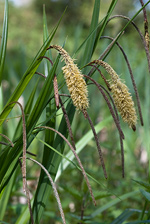 Pendulous Sedge Carex pendula |
Key for the identification of the known mines of British |
Note: Diptera larvae may live in a corridor mine, a corridor-blotch mine, or a blotch mine, but never in a case, a rolled or folded leaf, a tentiform mine or sandwiched between two more or less circular leaf sections in later instars. Pupation never in a cocoon. All mining Diptera larvae are leg-less maggots without a head capsule (see examples). They never have thoracic or abdominal legs. They do not have chewing mouthparts, although they do have a characteristic cephalo-pharyngeal skeleton (see examples), usually visible internally through the body wall. The larvae lie on their sides within the mine and use their pick-like mouthparts to feed on plant tissue. In some corridor miners frass may lie in two rows on alternate sides of the mine. In order to vacate the mine the fully grown larva cuts an exit slit, which is usually semi-circular (see Liriomyza huidobrensis video). The pupa is formed within the hardened last larval skin or puparium and as a result sheaths enclosing head appendages, wings and legs are not visible externally (see examples). See Key to non-Diptera. |
| 1# > Leaf-mine: Mine in central part of leaf, details unknown. |
|
Cerodontha mellita Spencer, 1971 [Diptera: Agromyzidae] |
| 1# > Leaf-mine: Undescribed. Pupation outside the mine. |
|
Metopomyza nigrohumeralis (Hendel, 1931) [Diptera: Agromyzidae] |
1a > Leaf-miner: A long yellowish green leaf-mine. Pupation external, puparium frequently adhering to leaf (Spencer, 1972b: 100; Spencer, 1976: 205). Long, rather broad corridor, about halfway along the leaf blade. Frass in a few large, black lumps. Puparium formed now in, then outside the mine. |
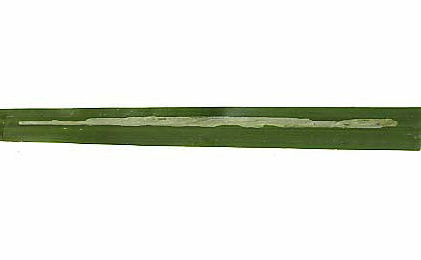 Mine of Cerodontha angulata on Carex pendula Image: © Willem Ellis (Bladmineerders van Europa) |
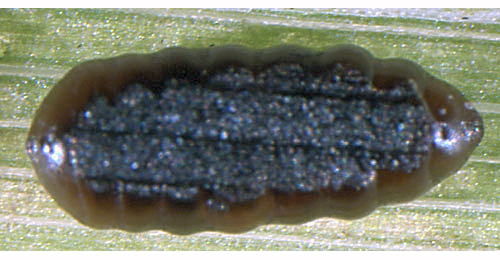 Cerodontha angulata puparium Image: © Willem Ellis (Bladmineerders van Europa) |
|
Cerodontha angulata (Loew, 1869) [Diptera: Agromyzidae]. |
1b > Leaf-miner: A long narrow greenish/yellowish mine. Pupation in leaf at end of mine (Spencer, 1976: 220). Long upper-surface corridor, mainly in the top half of the blade. The mine descends, but changes direction a few times (up, down, up). Frass in one big lump. Puparium in the mine, fastened ventrally in the mine with dried frass. The mine is a long gallery which is formed mostly in the apical parts of the leaf. |
|
Cerodontha caricicola (Hering, 1926) [Diptera: Agromyzidae]. |
| 1c > Leaf-miner: Linear
mine. Pupation either in the leaf at end of mine or externally (Spencer,
1976: 207).
Mine upper-surface, in the central part of the blade. Frass in a few large lumps; often all frass still is contained in the larva's intestine. Larva solitary. Puparium in the mine, fixed ventrally with dried frass. |
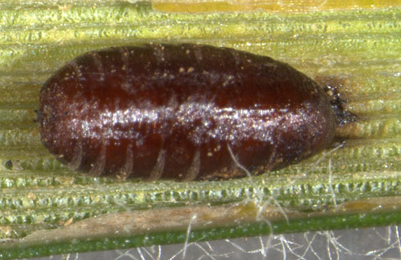 Cerodontha eucaricis puparium Image: © Willem Ellis (Bladmineerders van Europa) |
|
Cerodontha eucaricis Nowakowski, 1967 [Diptera: Agromyzidae]. |
| 1d > Leaf-miner: A
very long mine. Pupation at base of leaf (Spencer, 1972b: 100). Puparium brown
Very long upper-surface corridor, at the end about 1/3 of the width of the leaf. The mine usually begins about halfway along the blade and descends within the leaf sheath. Just before pupation all frass is deposited in one big mass. Puparium within the mine, where it also passes the winter. |
|
Cerodontha scirpi (Karl, 1926) [Diptera: Agromyzidae]. |
1e > Leaf-miner: Upper surface mine that finishes in the leaf sheath. Mine changes direction at least twice. Frass in one large lump. Pupation in the mine, usually in the leaf sheath. |
|
Cerodontha spinata (Groschke, 1954) [Diptera: Agromyzidae]. |
1f > Leaf-miner: Mines and larvae indistinguishable from C. morosa. Mine relatively short and broad, not extending into leaf base. Pupation in the mine (Spencer, 1976: 219). Upper-surface, interparenchymatous (therefore yellowish) corridor in the middle part of the leaf. The mine starts not far from the leaf tip, descends, and changes direction at least twice. Often in the end the corridor occupies the entire width of the leaf. Larva solitary. Frass in one big lump. Pupation inside the mine. The puparium is glued with frass to both the ceiling and the floor of the mine, parallel to the leaf vein. |
|
Cerodontha suturalis (Hendel, 1931) [Diptera: Agromyzidae]. |
1g > Mines and larvae indistinguishable from C. suturalis. Mine relatively short and broad, not extending into leaf base. Pupation in the mine (Spencer, 1976: 218). Long, upper-surface corridor, mainly in the central part of the blade. The mines descends, but changes direction a few times. Frass in one big lump. Pupation in the mine. |
|
Cerodontha morosa Meigen, 1830 [Diptera: Agromyzidae] |
1h > Leaf-mine: Mine in the leaf apex. Frass in a few large lumps. Pupation within the mine. |
|
Cerodontha pseuderrans (Hendel, 1931) [Diptera: Agromyzidae] |
| 1i > Leaf-mine: Mine upper-surface, sometimes locally interparenchymatous, in the basal half of the leaf. The mine is more or less a a corridor (but may sometimes occupy the entire width of the leaf), doubles at least twice, and often ends in the leaf sheath. All frass in one large lump. Puparium in the mine; often the rear spiracula penetrate the epidermis.. |
|
| Cerodontha staryi (Starý, 1930) [Diptera: Agromyzidae] |
1h > Leaf-miner: Upper surface, deep, narrow mine; frass in two regular rows; pupation external (Spencer, 1972b: 60, as flavoscutellaris). A short, descending corridor in a leaf sheath. Fress in few, isolated blad granules. Pupation outside the mine. |
|
Metopomyza flavonotata (Haliday, 1833) [Diptera: Agromyzidae]. |
1i > Leaf-miner: Upper-surface corridor, descending towards the leaf base, generally following the midrib. Frass in a double row of granules. Pupation outside the mine (Robbins, 1991). |
|
Metopomyza scutellata (Fallén, 1823) [Diptera: Agromyzidae]. |
1j > Leaf-miner: Mine initially lower surface running towards the apex, later continuing down towards the leaf base on the upper surface (developing into a broad blotch, with frass scattered irregularly). Pupation external (Spencer, 1972b: 60). The mine begins as a very narrow lower-surface corridor running in the direction of the leaf tip. Close to the tip the mine becomes upper-surface and redescends towards the leaf base, widening meanwihle, until all space between the midrib and a leaf margin is occupied. In the later parts of the mine frass in relatively coarse irregular grains. Pupation outside the mine. |
|
Metopomyza xanthaspis (Loew, 1858) [Diptera: Agromyzidae]. |
1k > Leaf-miner: Irregular mine, locally shallow, elsewhere much deeper, giving it a mottled appearance. In broadleaved plants the mine often begins as a blotch with stellate extensions, but sometimes as a very fine, shallow corridor. In grasses the mine often begins in the leaf sheath. The frass is very fine-grained, initially scattered, later in aggregates. The egg is deposited on the plant surface, and the empty egg shell remains visible. But the larvae are able to leave their mine and restart elsewhere, thus mines without an egg shell can be found as well. The larva also leaves the mine before pupation. Pupation takes place in a newly made, small, blotch mine without frass; this mine may be made in another plant (species). |
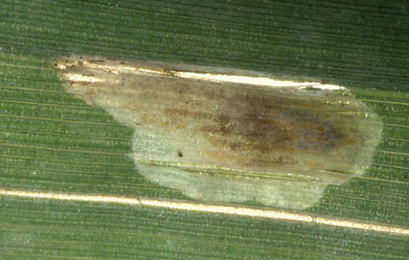 Mine of Hydrellia griseola on Glyceria fluitans Image: © Willem Ellis (Bladmineerders van Europa) |
|
Hydrellia griseola (Fallén, 1813) [Diptera: Ephydridae]. |
|
Key for the identification of the known mines of British |
Note: The larvae of mining Coleoptera, Hymenoptera and Lepidoptera may live in a corridor mine, a corridor-blotch mine, a blotch mine, a case, a rolled or folded leaf, a tentiform mine or sandwiched between two more or less circular leaf sections in later instars. Larva may pupate in a silk cocoon. The larva may have six legs (although they may be reduced or absent), a head capsule and chewing mouthparts with opposable mandibles (see video of a gracillarid larva feeding). Larvae of Hymenoptera and Lepidoptera usually also have abdominal legs (see examples). Frass, if present, never in two rows. Unless feeding externally from within a case the larva usually vacates the mine by chewing an exit hole. Pupa with visible head appendages, wings and legs which lie in sheaths (see examples). |
1# > Leaf-miner: Details unknown. |
|
Elachista kilmunella Stainton, 1849 [Lepidoptera: Elachistidae]. |
1a > Leaf-miner: Common reed and similar plants are the larval foodplant. The larva of this species has a peculiar habit of cutting part of a leaf to act as a raft, using this to float on the water to a new foodplant when necessary. Narrow, whitish, rather inflated corridor, sometimes several tens of centimeters long, running towards the leaf sheath. Frass in coarse grains, in a distinct central line. Now and then the larva makes a elongate case from leaf material and uses it to float to another hostplant. The case may stick for some time to the new host. The larva pupates in a stem, after having made an exit hole and closed it with silk. |
|
Donacaula forficella (Thunberg, 1794) [ Lepidoptera: Crambidae]. |
1b > Leaf-miner: Gradually widening corridor, running either upwards or down. All frass is deposited in the earliest part of the mine. Often 2-3 larvae in a mine; in grasses with broad leaves sometimes more than one mine in a leaf. |
|
Elachista adscitella Stainton, 1851 [Lepidoptera: Elachistidae]. |
1c > Leaf-miner: Corridor, 15 cm in the end, descending from the leaf tip. The mine is whtish and shallow at first, then becomes deeper, yellowish white, and more transparant. Pupation external; pupa, not in a cocoon, attached to the leaf. |
|
Elachista albidella Nylander, 1848 [Lepidoptera: Elachistidae]. |
1d > Leaf-miner: The narrow mine begins a few cm below the tip of the leaf and runs downwards, sometimes along the leaf margin, sometimes in the center of the leaf. After hibernation the larva probably begins a new, similar mine, that becomes quite long, ending near the leaf base. Frass in a brown, regularly interrupted line. Pupation external; pupa attached to the leaf, not in a cocoon. |
|
Elachista alpinella Stainton, 1854 [Lepidoptera: Elachistidae]. |
1e > Leaf-miner: The larva begins in autumn the making of a long, narrow, corridor with a fine central line of grey frass. The corridor is straight or lightly wavy, and descends into the leaf sheath, or even into the stem or rootstock. The larva regularly leaves the mine to begin making a new one. Pupation external. |
|
Elachista atricomella Stainton, 1849 [Lepidoptera: Elachistidae]. |
1f > Leaf-miner: Oviposition in a leaf axil. From there ascends a narrow corridor with a thin frass line. When the mine is 2-3 cm long the direction reverses. The result is an elongate, whitish, lightly inflated blotch with dispersed frass. Pupation external. |
|
Elachista biatomella (Stainton, 1848) [Lepidoptera: Elachistidae]. |
1g > Leaf-miner: Mine a descending and widening corridor, in the end an elongate blotch that may occupy the entire width of the leaf. The mine contracts somehat, narrowing the leaf. Frass in some elongate lumps in the centre of the mine. |
|
Elachista bisulcella (Duponchel, 1843) [Lepidoptera: Elachistidae]. |
1h > Leaf-miner: Mine generally descending from the leaf tip. The mine may occupy the space between leaf margin and midrib, but may also occupy the entire width of the leaf. Most frass accumulated in the oldest part of the mine. Pupation external; the pupa is attached to the leaf without a cocoon. Larval head and prothoracic shield dark brown, ody yellowish white, with a pair of orange red latero-dorsal length lines; ventrally another such line, medially. |
|
Elachista cinereopunctella (Haworth, 1828) [Lepidoptera: Elachistidae]. |
1i > Leaf-miner: Mine upper-surface, starting a few cm under the tip of the leaf.A corridor first runs upwards, then doubles, widening all the while. The final part takes half the width of the leaf. The complete corridor is c. 6 cm long; except for the last centimetres it is completely filled with frass (Bland, 1996a). Buhr (1964) describes the mine on Eleocharis as follows: The larva makes in the finest, almost bristle-like culms, descending from a spikelet, an almost full depth corridor in which only here and there a few green stripes remain. Frass very loose, in extremely fine dots of threads. Pupation external; the pupa is attached to the rear of the leaf, without a cocoon.. |
|
Biselachista eleochariella Stainton, 1851 [Lepidoptera: Elachistidae]. |
1j > Leaf-miner: The larva starts mining near a leaf tip in early autumn. This early mine approximates to being linear but is very erratic in its course. In earl winter the the larva usually moves to anew leaf. This second mine usually takes the form of a compact but irregularly brownish blotch close to or often within the area of purplish discoloration of the dying leaf tip. Occasionally the larva does not change mines but extends the one made in autumn. Pupation takes place in a concealed place amongst debris or between closely applied leaves (Bland and Knill-Jones, 1988). Egg generally at the underside of the leaf tip. From September until the following spring a narrow meandering corridor is made. Then gradually the corridor widens to nearly the full width of the leaf. Generally the larvae make a new mine in early winter, obviously without the initial corridor. The mine in this stage is brown and situated close to (or within) the red coloured dying apical part of the leaf. Frass in large elongate dark spots. Pupation external. |
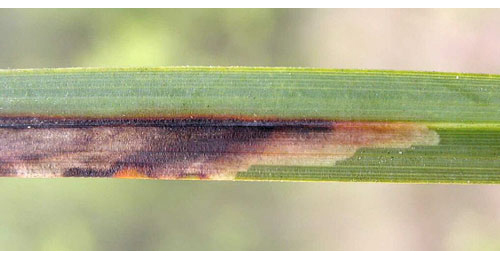 Mine of Elachista gleichenella on Carex flacca Image: © Jean-Yves Baugnée (Bladmineerders van Europa) |
|
Elachista gleichenella (Fabricius, 1781) [Lepidoptera: Elachistidae]. |
1k > Leaf-miner: In spring a short corridor is made that is almost stuffed with frass. After hibernation this mine is vacated, and the larva then makes a number of elongated blotches, all descending from the leaf tip. These latter mines are whitish, with irregularly scattered frass. |
|
Elachista humilis Zeller, 1850 [Lepidoptera: Elachistidae]. |
1l > Leaf-miner: Initially a narrow brownish mine with blackish frass at its base, then moves to another leaf, forming a broader mine. Both mines can pucker the blade. |
|
Elachista obliquella Stainton, 1858 [Lepidoptera: Elachistidae]. |
1m > Leaf-miner: In autumn the larva makes a long, brown corridor, and hibernates therein. In spring a new mine is made in another leaf. This one starts near the base of the blade, widens upwards, and finally forms an elongate yellowish irregular blotch of 3-5 cm in length. According to Martini (1912a) a characteristic of this species is the extreme precision with which the mine joins up with the length venation of the leaf. Pupation external; the pupa is attached to the mine without a cocoon. |
|
Elachista serricornis (Stainton, 1854) [Lepidoptera: Elachistidae]. |
1n > Leaf-miner: Mines downwards from leaf tip to stem. Makes a long narrow yellowish mine. May be up to four larvae in one leaf. Long narrow yellowish corridor, descending from the leaf tip to its base; at times 3-4 larvae in a leaf. Often several larvae in a communal mine. Pupation outside the mine. |
|
Elachista stabilella Stainton, 1858 [Lepidoptera: Elachistidae]. |
1o > Leaf-miner: The larva creates a long narrow mine in the blade. Mine fairly translucent. It starts as a narrow corridor, running towards the leaf tip, but this almost invariably is overrun be a later, broad, descending corridor. The centre of the mine contains a vertical tube made of loose silk, in which the larva can quickly move up or down, and in which also most frass gets trapped. The sides of the mine are smooth (contrary to E. gangabella). Mines are difficult to find, because the leaves are wilting when larvae are present. |
|
Elachista subalbidella Schläger, 1847 [Lepidoptera: Elachistidae]. |
1p > Leaf-miner: The mine begins somewhere halfway the blade as an upwards running corridor. After a while the direction reverses, and an elongate blotch develops occupying half the width of the leaf. Frass, light green at first, grey later, concentrated in the lowest part of the mine. Pupation external. |
|
Elachista utonella Frey, 1856 [Lepidoptera: Elachistidae]. |
1q > Leaf-miner: Rather narrow, long, corridor, of which the course largely is dictated by the venation; the mine may change direction (up/down). The larva may leave its mine and restart elsewhwere. Pupation within the mine; pupa in a white cocoon, just above the waterline. |
|
Monochroa arundinetella (Stainton, 1858) [Lepidoptera: Elachistidae]. |
| Last updated 01-Jul-2019 Brian Pitkin | ||
